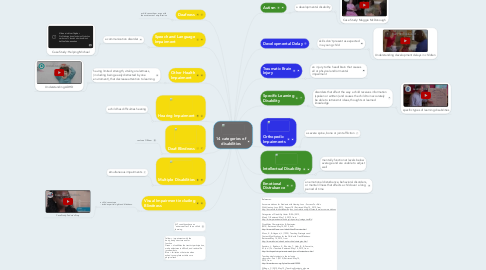14 categories of disabilities
作者:Meagan Redding


1. Deafness
1.1. a child cannot hear, even with the assistance of amplification
2. Speech and Language Impairment
2.1. a communication disorder
2.1.1. Case Study: Helping Michael
3. Other Health Impairment
3.1. having limited strength, vitality, or alertness, (including being easily distracted by one enviroment), that decrease attention to learning
3.1.1. Understanding ADHD
4. Hearing Impairment
4.1. a child has difficulties hearing
5. Deaf-Blindness
5.1. can't see OR hear
6. Multiple Disabilities
6.1. simultaneous impairments
7. Visual Impairment including Blindness
7.1. a child cannot see - includes partial sight and blindness.
7.1.1. Case Study: Fadzie's Story
8. All* conditions have an "adverse affect" the a child's learning
9. Yellow = impairments with the body, body structure and/or function Green = disabilities that restrict participation, make adjustments difficult, and reduce life involvements Blue = limitations that arise when asked to complete activities or a physical task
10. Autism
10.1. a developmental disability
10.1.1. Case Study: Maggie McDonough
11. Developmental Delay
11.1. skills don't present as expected in a young child
11.1.1. Understanding development delays in children
12. Traumatic Brain Injury
12.1. an injury to the head/brain that causes all or phsyical and/or mental impairment
13. Specific Learning Disability
13.1. disorders that affect the way a child receives information (spoken or written) and causes the child to inaccurately be able to retransmit ideas, thoughts or learned knowledge
13.1.1. specific types of learning disabilities

